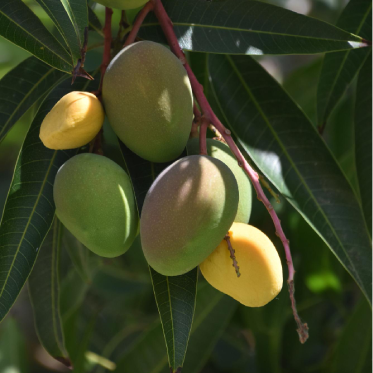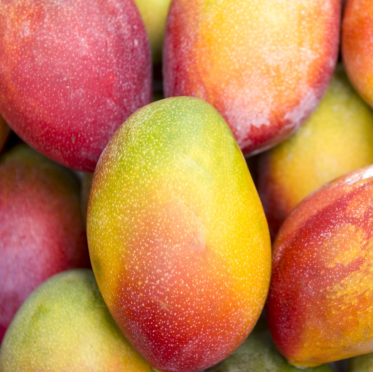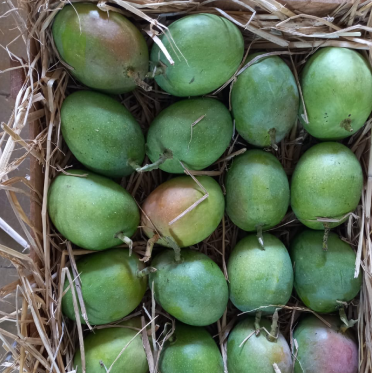India, the largest producer of mangoes, boasts a dazzling array of mango varieties, each with its unique flavor profile, aroma, and texture. Here’s an overview of some prominent mango varieties and their distinct flavors:
- Alphonso (Hapus) – Maharashtra, Gujarat, Karnataka
- Flavor: Rich, creamy, and intensely sweet with a subtle saffron-like aftertaste.
- Aroma: Strong, floral fragrance.
- Texture: Non-fibrous, buttery, and smooth.
- Best For: Desserts, juices, and fresh consumption.
- Kesar – Gujarat
- Flavor: Sweet and tangy with a slight floral undertone.
- Aroma: Mildly spicy and aromatic.
- Texture: Smooth and soft pulp.
- Best For: Milkshakes, ice creams, and aamras.
- Dasheri – Uttar Pradesh
- Flavor: Sweet with a subtle honey-like note.
- Aroma: Mild and pleasant.
- Texture: Soft and fibrous.
- Best For: Direct consumption and making pickles.
- Langra – Uttar Pradesh, Bihar
- Flavor: Sweet with a hint of tanginess.
- Aroma: Refreshingly mild.
- Texture: Fibrous with firm pulp.
- Best For: Juices and chutneys.
- Banganapalli (Benishan) – Andhra Pradesh, Telangana
- Flavor: Sweet with a slight tartness and a lingering buttery taste.
- Aroma: Mild and fruity.
- Texture: Non-fibrous and firm.
- Best For: Slicing and eating fresh.
- Himsagar – West Bengal, Odisha
- Flavor: Intensely sweet and aromatic, often described as honey-like.
- Aroma: Strong and fruity.
- Texture: Smooth, non-fibrous pulp.
- Best For: Desserts and milk-based drinks.
- Chausa – Uttar Pradesh, Punjab
- Flavor: Sweet with a pleasant tangy finish.
- Aroma: Mild and inviting.
- Texture: Fibrous and juicy.
- Best For: Juices and pulps.
- Totapuri – Karnataka, Andhra Pradesh, Tamil Nadu
- Flavor: Mildly sweet with a distinct tangy kick.
- Aroma: Light and tropical.
- Texture: Firm and fibrous.
- Best For: Pickles, salads, and drinks.
- Neelum – Tamil Nadu, Karnataka
- Flavor: Sweet with a slight resinous aftertaste.
- Aroma: Subtle and spicy.
- Texture: Firm and slightly fibrous.
- Best For: Blending in juices and purees.
- Amrapali – All-India (Hybrid of Dasheri and Neelum)
- Flavor: Intensely sweet and rich.
- Aroma: Distinct and fruity.
- Texture: Non-fibrous with smooth pulp.
- Best For: Making jams, squashes, and fresh consumption.
- Mulgoba – Tamil Nadu
- Flavor: Very sweet with a hint of sourness.
- Aroma: Earthy and tropical.
- Texture: Non-fibrous with a creamy consistency.
- Best For: Eating fresh and making purees.
- Imam Pasand – Andhra Pradesh, Tamil Nadu
- Flavor: Sweet with complex notes of citrus and honey.
- Aroma: Rich and fruity.
- Texture: Non-fibrous with smooth flesh.
- Best For: Gourmet dishes and salads.
- Pairi – Maharashtra, Goa
- Flavor: Sweet with a sharp tanginess.
- Aroma: Strong and spicy.
- Texture: Juicy and slightly fibrous.
- Best For: Juices, pickles, and aamras.
- Mallika – All-India (Hybrid of Neelum and Dasheri)
- Flavor: Sweet with hints of citrus and melon.
- Aroma: Fruity and floral.
- Texture: Non-fibrous with smooth pulp.
- Best For: Making thick smoothies and desserts.
- Fazli – Bihar, West Bengal
- Flavor: Mildly sweet with a tangy twist.
- Aroma: Subtle and earthy.
- Texture: Fibrous and juicy.
- Best For: Making mango-based drinks and curries.
- Sindhri – Rajasthan
- Flavor: Sweet with a silky finish.
- Aroma: Strong and tropical.
- Texture: Non-fibrous, velvety pulp.
- Best For: Fresh consumption and desserts.
Flavors in Indian Mangoes:
- Sweetness: Predominant in Alphonso, Kesar, and Himsagar.
- Tanginess: Found in Totapuri, Langra, and Pairi.
- Citrus/Complex Notes: Distinct in Imam Pasand and Mallika.
- Earthy and Aromatic: Unique to Mulgoba and Fazli.
India’s mango varieties are a testament to the diversity of its climates and soils, each offering a unique culinary experience.












